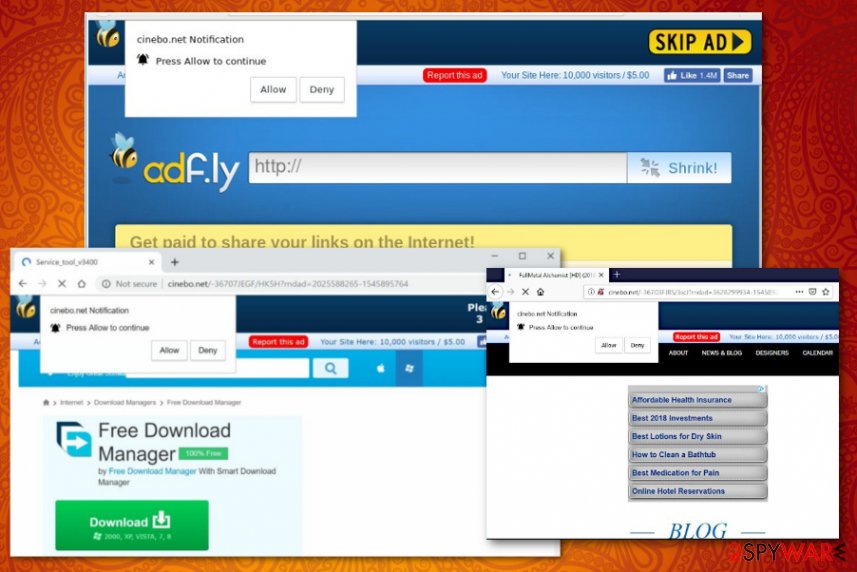Remove Cinebo.net redirect virus
Cinebo.net Removal Guide
What is Cinebo.net?
Cinebo.net is the web browser redirect that is related to advertising services, so promotes questionable tools on the pop-ups and banners

Cinebo.net is the application that promotes questionable content and generates revenue for the publisher from all the suspicious redirects. This is a program categorized as adware because the primary purpose is to show advertisements, cause redirects and inject various intrusive browser extensions or add-ons without any permission. You may encounter redirects to the website or advertisements inserted on pages you commonly visit, and once the content gets clicked on tons of tabs or windows open up. These redirects fill up your screen and keep from accessing useful pages or even browsing online in general.
Once Cinebo.net redirect virus gets on the system, it affects various parts of the machine, including startup preferences and the browser performance, as well as the general speed of the PC. Users also complain that it is difficult to remove this adware since it adds more useless files and applications to the machine and web browser. It can also alter settings and registry keys, so the program gets launched every time the user reboots its device.
| Name | Cinebo.net |
|---|---|
| Type | Adware/ push notifications virus |
| Category | Potentially unwanted program |
| Symptoms | Commercial content gets delivered on the screen and fills up the browser. Various redirects to shady pages expose to possibly malicious material |
| Distribution | Deceptive sites, advertisements, software bundling |
| Elimination | Clean your device with anti-malware tool and remove Cinebo.net |
| Possible danger | PUP tracks and records data about users online activity and shares that information with third-party companies[1] |
Cinebo.net is the push notifications virus that makes users puzzled when this website or any other commercial page appears on the browser. Redirects to common pages without any useful material indicate the PUP ruining on the machine. Once you get redirected to this site page automatically re-loads to adf.ly which is also a questionable ad-supported program.
Cinebo.net virus is a potentially unwanted program so don't get surprised when other pages get displayed beside the main redirect, and other web browser material shows up installed without the permission or knowledge. The adware can download and install content without requiring for users' agreement:
- browser extensions;
- rogue system tools;
- fake antivirus programs;
- applications;
- add-ons;
- plugins;
- browser toolbars.
There are many different types of potentially unwanted programs, but all of them have many similar features. Cinebo.net is the adware-type cyber threat, and the primary purpose of this application is to generate revenue for the publisher/advertiser. Many ad-supported programs work the same, and all the redirects, banners, pop-up ads, and in-text-links are helping to achieve such purposes.

However, Cinebo.net have one distinct feature that all potentially unwanted programs have – data tracking. From the minute this application comes to the computer it gets access to various details about the user and his or her browsing activities. Each click on the commercial content, redirect or the shady site also allows the publisher to read browsing history, see most visited pages and searched items or even get the location and IP address of the particular device.
Such information is important for the advertisers and sponsors, Cinebo.net developers because this data is valuable for malvertising purposes and generating personalized advertisements that can be more geared towards each user and victim. When ads show promotional content with things you are interested in, it is more likely that you can purchase the application or just visit the sponsored website.[2]
All the intrusive content and the data tracking issue should make you eager to remove Cinebo.net as soon as possible. Experts[3] recommend reacting to such unwanted activity immediately after noticing anything suspicious. The PUP runs on the machine before it starts showing any symptoms, so it is possible that your device was infected a long time ago before you experience redirects.
When you try to perform Cinebo.net removal, remember to consider all the additional content this intruder can install without your knowledge. To terminate all the questionable behavior and background processes, you need to delete all associated files and applications. Automatic PUP elimination is the way to go.
For the best results, you should employ a trustworthy anti-malware program and run a full system scan on the device that got affected by Cinebo.net virus. We recommend relying on professional anti-malware programs to ensure proper system cleaning. You can also try FortectIntego tool to fix virus damage and other system issues.

Installing questionable software from unreliable sources may lead to PUP infiltrations
Since the internet is filled with various pages offering free downloads of software and applications, you need to choose the source of programs wisely and pay attention to processes happening on the machine, including installations and downloads, especially when you get tools not from the official developer or provider.
You can avoid unwanted infiltrations if you choose an official provider, other reliable sources, and go for Advanced or Custom freeware installations every time. This method allows de-selecting unwanted programs from the bundled list and installs the needed applications only that you give permission for.
Eliminate Cinebo.net with automatic antivirus tools and make the system PUP-free
For the proper Cinebo.net removal results, you should think about the system cleaning because all extensions or applications can affect the performance besides to the PUP activities. Altered registry keys and startup preferences can also change the overall elimination and make the adware more persistent.
When you want to remove Cinebo.net from the computer once and for all, you need to get a reliable anti-malware program and scan the machine fully. Once you do that, you should check all the web browsers and reset them to default to change all the settings that may get altered by the PUP.
You may remove virus damage with a help of FortectIntego. SpyHunter 5Combo Cleaner and Malwarebytes are recommended to detect potentially unwanted programs and viruses with all their files and registry entries that are related to them.
Getting rid of Cinebo.net. Follow these steps
Uninstall from Windows
Get rid of Cinebo.net ads and clean the machine to ensure normal performance and better speed
Instructions for Windows 10/8 machines:
- Enter Control Panel into Windows search box and hit Enter or click on the search result.
- Under Programs, select Uninstall a program.

- From the list, find the entry of the suspicious program.
- Right-click on the application and select Uninstall.
- If User Account Control shows up, click Yes.
- Wait till uninstallation process is complete and click OK.

If you are Windows 7/XP user, proceed with the following instructions:
- Click on Windows Start > Control Panel located on the right pane (if you are Windows XP user, click on Add/Remove Programs).
- In Control Panel, select Programs > Uninstall a program.

- Pick the unwanted application by clicking on it once.
- At the top, click Uninstall/Change.
- In the confirmation prompt, pick Yes.
- Click OK once the removal process is finished.
Delete from macOS
Remove items from Applications folder:
- From the menu bar, select Go > Applications.
- In the Applications folder, look for all related entries.
- Click on the app and drag it to Trash (or right-click and pick Move to Trash)

To fully remove an unwanted app, you need to access Application Support, LaunchAgents, and LaunchDaemons folders and delete relevant files:
- Select Go > Go to Folder.
- Enter /Library/Application Support and click Go or press Enter.
- In the Application Support folder, look for any dubious entries and then delete them.
- Now enter /Library/LaunchAgents and /Library/LaunchDaemons folders the same way and terminate all the related .plist files.

Remove from Microsoft Edge
Delete unwanted extensions from MS Edge:
- Select Menu (three horizontal dots at the top-right of the browser window) and pick Extensions.
- From the list, pick the extension and click on the Gear icon.
- Click on Uninstall at the bottom.

Clear cookies and other browser data:
- Click on the Menu (three horizontal dots at the top-right of the browser window) and select Privacy & security.
- Under Clear browsing data, pick Choose what to clear.
- Select everything (apart from passwords, although you might want to include Media licenses as well, if applicable) and click on Clear.

Restore new tab and homepage settings:
- Click the menu icon and choose Settings.
- Then find On startup section.
- Click Disable if you found any suspicious domain.
Reset MS Edge if the above steps did not work:
- Press on Ctrl + Shift + Esc to open Task Manager.
- Click on More details arrow at the bottom of the window.
- Select Details tab.
- Now scroll down and locate every entry with Microsoft Edge name in it. Right-click on each of them and select End Task to stop MS Edge from running.

If this solution failed to help you, you need to use an advanced Edge reset method. Note that you need to backup your data before proceeding.
- Find the following folder on your computer: C:\\Users\\%username%\\AppData\\Local\\Packages\\Microsoft.MicrosoftEdge_8wekyb3d8bbwe.
- Press Ctrl + A on your keyboard to select all folders.
- Right-click on them and pick Delete

- Now right-click on the Start button and pick Windows PowerShell (Admin).
- When the new window opens, copy and paste the following command, and then press Enter:
Get-AppXPackage -AllUsers -Name Microsoft.MicrosoftEdge | Foreach {Add-AppxPackage -DisableDevelopmentMode -Register “$($_.InstallLocation)\\AppXManifest.xml” -Verbose

Instructions for Chromium-based Edge
Delete extensions from MS Edge (Chromium):
- Open Edge and click select Settings > Extensions.
- Delete unwanted extensions by clicking Remove.

Clear cache and site data:
- Click on Menu and go to Settings.
- Select Privacy, search and services.
- Under Clear browsing data, pick Choose what to clear.
- Under Time range, pick All time.
- Select Clear now.

Reset Chromium-based MS Edge:
- Click on Menu and select Settings.
- On the left side, pick Reset settings.
- Select Restore settings to their default values.
- Confirm with Reset.

Remove from Mozilla Firefox (FF)
Check for additional material installed by the PUP itself without your permission
Remove dangerous extensions:
- Open Mozilla Firefox browser and click on the Menu (three horizontal lines at the top-right of the window).
- Select Add-ons.
- In here, select unwanted plugin and click Remove.

Reset the homepage:
- Click three horizontal lines at the top right corner to open the menu.
- Choose Options.
- Under Home options, enter your preferred site that will open every time you newly open the Mozilla Firefox.
Clear cookies and site data:
- Click Menu and pick Settings.
- Go to Privacy & Security section.
- Scroll down to locate Cookies and Site Data.
- Click on Clear Data…
- Select Cookies and Site Data, as well as Cached Web Content and press Clear.

Reset Mozilla Firefox
If clearing the browser as explained above did not help, reset Mozilla Firefox:
- Open Mozilla Firefox browser and click the Menu.
- Go to Help and then choose Troubleshooting Information.

- Under Give Firefox a tune up section, click on Refresh Firefox…
- Once the pop-up shows up, confirm the action by pressing on Refresh Firefox.

Remove from Google Chrome
Make the web browser running normally by eliminating Cinebo.net adware and all related content
Delete malicious extensions from Google Chrome:
- Open Google Chrome, click on the Menu (three vertical dots at the top-right corner) and select More tools > Extensions.
- In the newly opened window, you will see all the installed extensions. Uninstall all the suspicious plugins that might be related to the unwanted program by clicking Remove.

Clear cache and web data from Chrome:
- Click on Menu and pick Settings.
- Under Privacy and security, select Clear browsing data.
- Select Browsing history, Cookies and other site data, as well as Cached images and files.
- Click Clear data.

Change your homepage:
- Click menu and choose Settings.
- Look for a suspicious site in the On startup section.
- Click on Open a specific or set of pages and click on three dots to find the Remove option.
Reset Google Chrome:
If the previous methods did not help you, reset Google Chrome to eliminate all the unwanted components:
- Click on Menu and select Settings.
- In the Settings, scroll down and click Advanced.
- Scroll down and locate Reset and clean up section.
- Now click Restore settings to their original defaults.
- Confirm with Reset settings.

Delete from Safari
Remove unwanted extensions from Safari:
- Click Safari > Preferences…
- In the new window, pick Extensions.
- Select the unwanted extension and select Uninstall.

Clear cookies and other website data from Safari:
- Click Safari > Clear History…
- From the drop-down menu under Clear, pick all history.
- Confirm with Clear History.

Reset Safari if the above-mentioned steps did not help you:
- Click Safari > Preferences…
- Go to Advanced tab.
- Tick the Show Develop menu in menu bar.
- From the menu bar, click Develop, and then select Empty Caches.

After uninstalling this potentially unwanted program (PUP) and fixing each of your web browsers, we recommend you to scan your PC system with a reputable anti-spyware. This will help you to get rid of Cinebo.net registry traces and will also identify related parasites or possible malware infections on your computer. For that you can use our top-rated malware remover: FortectIntego, SpyHunter 5Combo Cleaner or Malwarebytes.
How to prevent from getting adware
Stream videos without limitations, no matter where you are
There are multiple parties that could find out almost anything about you by checking your online activity. While this is highly unlikely, advertisers and tech companies are constantly tracking you online. The first step to privacy should be a secure browser that focuses on tracker reduction to a minimum.
Even if you employ a secure browser, you will not be able to access websites that are restricted due to local government laws or other reasons. In other words, you may not be able to stream Disney+ or US-based Netflix in some countries. To bypass these restrictions, you can employ a powerful Private Internet Access VPN, which provides dedicated servers for torrenting and streaming, not slowing you down in the process.
Data backups are important – recover your lost files
Ransomware is one of the biggest threats to personal data. Once it is executed on a machine, it launches a sophisticated encryption algorithm that locks all your files, although it does not destroy them. The most common misconception is that anti-malware software can return files to their previous states. This is not true, however, and data remains locked after the malicious payload is deleted.
While regular data backups are the only secure method to recover your files after a ransomware attack, tools such as Data Recovery Pro can also be effective and restore at least some of your lost data.
- ^ Sarah Meyer. Online behavioral tracking: who's spying on your every move?. CPOmagazine. Data protection, privacy and cyber security news.
- ^ Malvertising. Wikipedia. The free encyclopedia.
- ^ Virusai. Virusai. Spyware related news.























